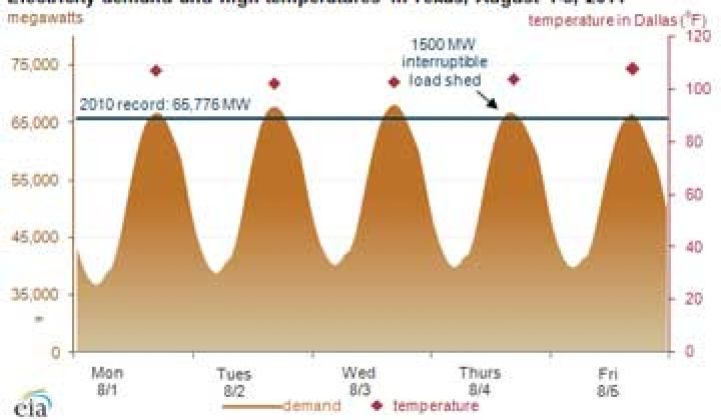Hot summers are certainly not novel in Texas, but for the electric grid, the triple digits recently pushed capacity to new levels.
Texas’ power grid set record level power use for three consecutive days last week. The high demand topped off at 68,294 megawatts on Wednesday. The near-peak electricity use continued through the end of the week, with the grid operator ERCOT calling on demand response on Thursday despite slightly lower consumption. Wind contributed about 2,000 megawatts during some of the most crucial hours on Wednesday. ERCOT issued a level 2 alert for rolling blackouts, although they were ultimately avoided. The grid survived, but there is still a lot of room for improvement.
Like PJM Interconnection just a few weeks ago, ERCOT did not call on its demand response services on the record-setting day, but rather the following day when some generation units were offline. ERCOT used about 1,150 MW of responsive reserves on Thursday and another 440 MW of emergency interruptible load shed, according to Mark Patterson, manager of demand integration at ERCOT.
The demand for energy sent prices sky high, topping out at $2,500 per megawatt-hour on Friday afternoon, more than 50 times the on-peak wholesale average, according to the U.S. Energy Information Administration.
With wind and demand response coming to the rescue, ERCOT and other regions are being buoyed during heat waves by technology and generation enabled by a smarter grid. Like the heat wave across the Midwest and East, however, it's not a win for smart grid, but more like advancing through the early rounds.
In Texas, demand response is currently limited to capacity and frequency regulation and does not play in the non-spin market, where it would need to be dispatched in real time. ERCOT is currently looking into how this would work, and Patterson said they’re putting together a pilot project. Until demand response can be shed in real time, it will continue to be a limited resource for grid operators. “It’s a pretty extensive project,” Patterson said of ERCOT's efforts in evaluating how demand response could function in the non-spin markets.
Patterson also pointed to the millions of smart meters that have been, and continue to be, deployed in the Lone Star State. Because Texas is a deregulated market, “There’s a disconnect about who owns the customer and it becomes a bit of a problem for demand response,” he said.
There is some residential DR in Texas, such as with Ecofactor and Oncor’s pilot program, but there could be a whole lot more. Single homes don’t offer the load shed of large industrial customers, but there are meaningful megawatts that can be curbed through aggregation.
Like non-spin reserves, there will likely need to be a good deal of automation for any significant uptake. While non-spin demand response needs to be automatic so that it can interface with grid operators in real time, on the residential side, automation is needed so as not to sacrifice (and anger) customers -- especially in Texas, where people shop around for their electricity far more than in any other state in the U.S.
During the heat wave on the East Coast, for example, Baltimore Gas & Electric received complaints when it cycled off people’s AC units, despite the fact the customers had signed up for the PeakSavers program, which allows BG&E to turn down a customer's AC during peak days.
The ability to utilize the meters for more sophisticated applications is coming in Texas -- the question now is when. Patterson noted that San Antonio, which is not included in the deregulated market, is going to use its meters to create a 250 MW virtual power plant using demand response. Co-ops and municipalities are likely to lead the way in Texas, but others will follow. ERCOT currently has a working group looking into the issue. “It’s probably going to take a few more years before we have significant levels of demand response due to meters,” said Patterson.



